Emerging Connections
Expanding Earth Science Learning Through International Collaboration
The Western Science Center (WSC), a regional natural history museum in southern California, primarily houses local, Pleistocene (Ice Age) fossils of animals such as mammoths, a saber-toothed cat, and others. In addition to the collections, outreach is an essential component of the museum’s purpose; WSC educates people with in-museum visits and programming, and off-site events, such as a mobile museum at airshows and park openings. The museum staff became interested in starting a program for local museum visitors to experience and understand local fossils in a global context. The International Collaborations for Education (I.C.E.) Age Project began in spring 2018. To disseminate knowledge about the local fossils as compared with fossils elsewhere, a museum educator initiated collaborations between students in California and at distant schools while acting in an intermediary and support position. The museum educator was responsible for
- connecting the two classroom teachers,
- scaffolding the teachers’ use of video conferencing software for the collaboration (either through instruction before scheduled class meetings or during class with students to model the behavior),
- designing and maintaining the website for student and teacher use, and
- conducting the pre- and posttests and interviews.
Partnerships between agencies of informal education and K–12 institutions have captured greater interest in recent years (Bevan et al. 2010; Kilpatrick and McCarthy 2015). Collaborating with museums provides an opportunity for authentic learning experiences in a context outside the typical pattern for in-school programming. For the museum, such collaborations enable staff to promote two parts of its mission to “advance knowledge of the region’s natural history and cultural heritage . . .” and “convey to students and the general public an appreciation of science and mathematics as essential for understanding the natural world….”
The Need for Global Collaboration
As Thomas Friedman (2005) pointed out, the world economy has become globalized, meaning goods can be transported worldwide and services can be rendered remotely. Even though we are a fifth of the way into the 21st century and deeply immersed in the age of the internet, schools have not changed significantly and thus are not preparing students as well as they could with 21st-century skills, including global competency and human interconnections (Jimenez 2020). This globalized economy requires participants to possess global mindedness, a worldview in which an individual perceives oneself as belonging to the world community and feeling a sense of responsibility for its members (Cook 2016). Unfortunately, many workers within the United States lack global mindedness (Wagner 2014) limiting the type of jobs for which they can be hired. Students may improve their global mindedness through international experiences. Global education provides students with the international experience and necessary skills to be a “new kind of graduate” (Mansilla and Jackson 2011, p. 1) demanded by global markets. Cook (2016) stated, “Global education provides the means for interacting across cultures (p. 4).” This work aimed to test whether global collaborations improve global mindedness for middle school students in California relative to domestic partnerships. The need for improved global competencies and a sense of global mindedness became the basis for the logic model depicted in Figure 1. Global mindedness differs from global competencies, which are skills a person acquires. Global competencies include recognizing different perspectives, taking action, communicating ideas, and investigating the world (Mansilla and Jackson 2011).
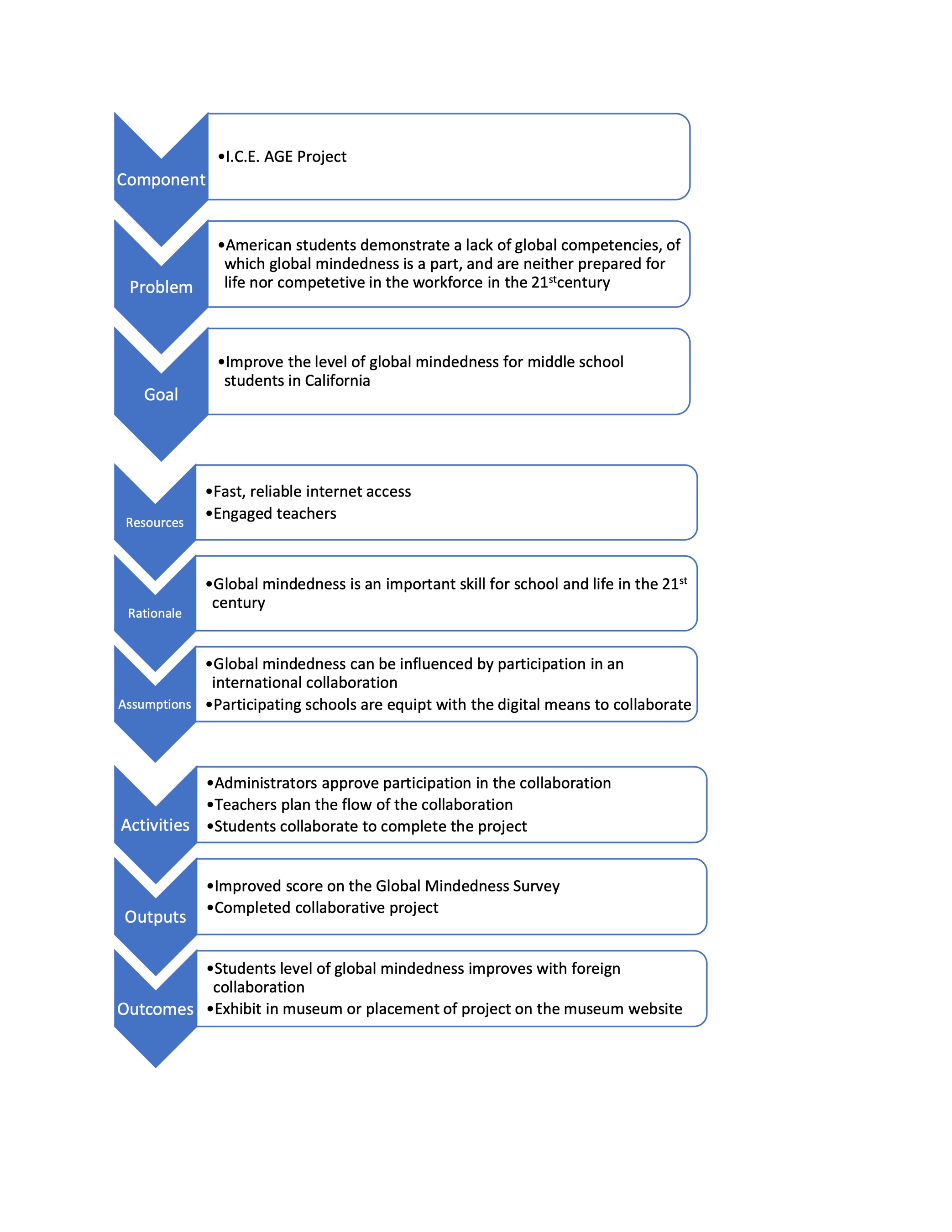
The National Science Teaching Association (NSTA) encourages educators to engage in international collaborations with fellow educators and students (NSTA 2017). International collaborations previously were limited to pen pal situations, which involved long delays while mail was distributed and returned. Today’s partnerships are virtually instantaneous with digital technologies. Anyone with a good internet connection, computer, and webcam can take part in global collaborations.
The Asia Society’s Global Competence Matrix includes communication (Mansilla and Jackson 2011), which is also an essential skill for success in higher education and the workforce. The Next Generation Science Standards (NGSS) integrates the concepts of communicating ideas within each standard (NGSS Lead States 2013). As an example, one of the NGSS standards, 5-LS1-1, states students should “Support an argument that plants get the material they need for growth chiefly from air and water” (NGSS Lead States 2013). To support the argument, students must verbally or in writing convey the lines of evidence to support their idea. This study highlights the significance of communication during the collaborations.
Global topics also appear in the NGSS and are vital to success with 21st-century skills and knowledge. Climate standards within the NGSS represent such a topic. For example, standard MS-ESS3-5 states, “Ask questions to clarify evidence of the factors that have caused the rise in global temperatures over the past century” (NGSS Lead States 2013). To answer the questions that arise, students must recognize both that this issue is global and that anthropogenic causes need to be forefront in any discussion.
Layered collaborations
Three distinct layers—each of which was necessary to make the cooperative venture work—were embedded in the I.C.E. Age collaborations. The first collaborative layer occurred at an institutional level (i.e., the interactions between the leaders of the museum and the participating schools who initiated the project and supported it to completion). The second cooperative layer developed between the facilitators (i.e., the classroom teacher and staff from the museum responsible for project implementation). The third layer was composed of the actors (i.e., the students from classrooms in two different locations participating in each recurrence of the I.C.E. Age Project). (See Figure 2.)
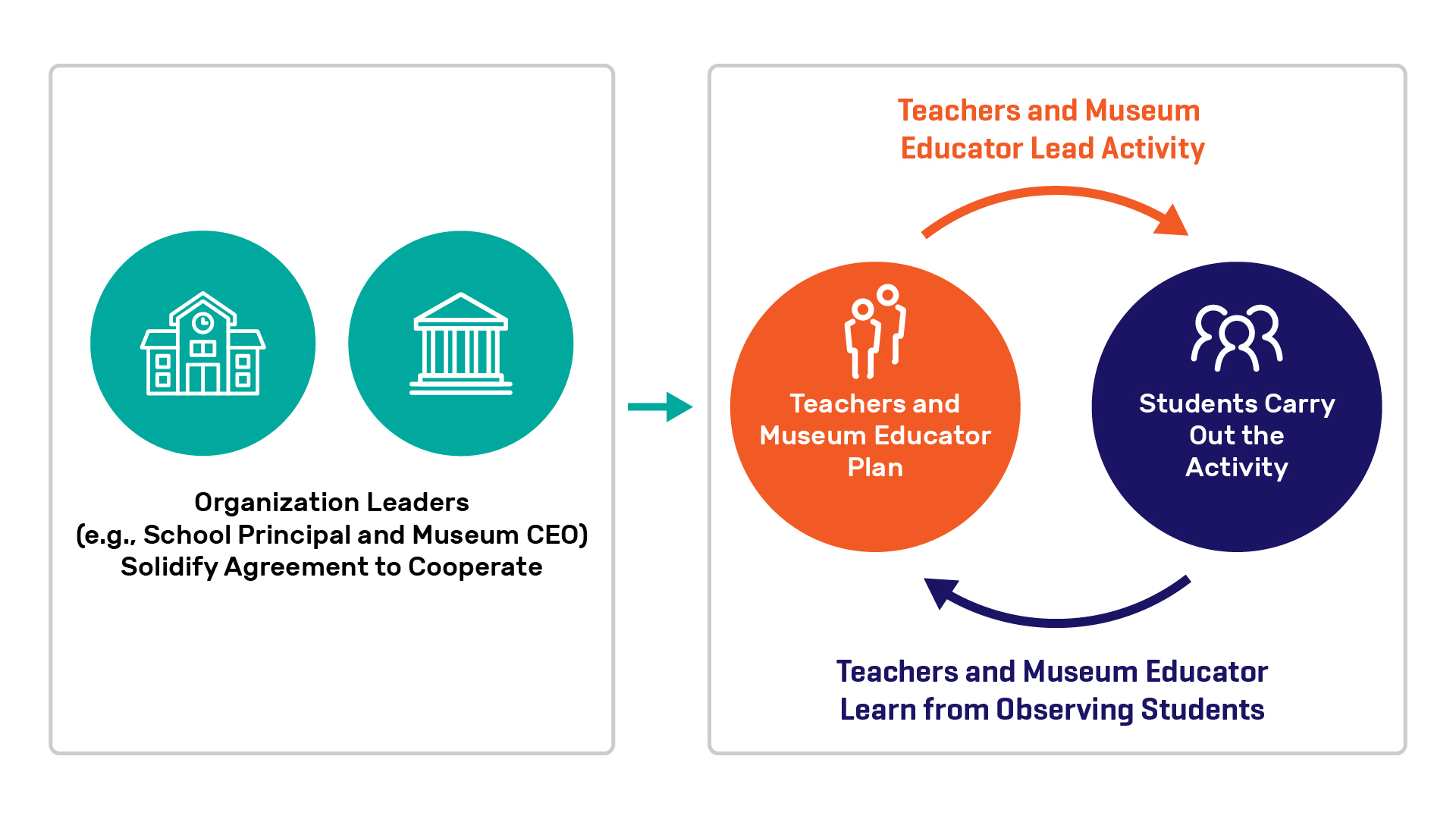
Repetitions of the I.C.E. Age Project
Each iteration of the I.C.E. Age Project included two paired classrooms—one local to the museum and one elsewhere in the United States or in an international location. Described here are three versions of the I.C.E. Age Project, two with international partners and one with a domestic partner; researchers collected data between 2018 and 2019.
Initial Parameters
In each of the three collaborations students performed two tasks. First, students worked with their partner (in Brazil or Indiana) to do guided research about Ice Age animals; they used a Webquest format that asked them to compare climate in the two areas and the change in fauna resulting from the end-Pleistocene extinction. Second, the students exchanged more personal information, such as favorite singer or TV show. The assumptions by those at the leadership and facilitator levels were that students (1) had never taken part in a collaboration of this nature, (2) may not be familiar with Ice Age animals, (3) may not be familiar with Webquests, and (4) would be proficient users of Google products.
Assessing Global Mindedness
Students’ global mindedness was assessed by three methods:
- The teachers located in the United States were interviewed one-on-one about their students’ global mindedness before and after each collaboration.
- Students in both collaborating classrooms in California were interviewed one-on-one by the first author with a supervising adult present at the end of their participation in the program, for a total of 12 students in three different classrooms.
- The Global Mindedness Survey (GMS; Appendix A, see Supplemental Resources) (Cook 2016) was administered as a pre- and posttest with participant students in the second and third repetitions.
The GMS asked students to respond to 18 items with a 5-point Likert-type scale, with 1 = strongly disagree to 5 = strongly agree. The instrument measured four components (i.e., variables) of the global mindedness construct, including Cultural Pluralism (5 items), Responsibility (5 items), Efficacy (4 items), and Interconnectedness (4 items). Each variable was defined as the mean of the items that were designed to measure the elements, with higher scores signaling a well-developed global-mindedness element and lower scores indicating a poorly developed element. Student pre- and posttests were matched by students using anonymous coding created by the teacher.
The museum educator conducted pre- and post-collaboration interviews with teachers, which provided insight into their perceived change of students’ level of global mindedness. (See Appendix B, see Supplemental Resources, for a script of teacher questions. These questions were slightly modified for interviews with students.) Small groups of approximately four students (selected by their teacher) were interviewed after the second and third program offerings.
Informal observations by the museum educator enhanced findings from the teacher and student interviews. The educator randomly selected three students to observe for 10–15 minutes each session and took notes on the students’ participation. Weekly observations gave the museum educator a firsthand view of how the collaborations unfolded. During these observations, the educator tallied numbers of references to global competencies, for example:
- multiple perspectives (such as recognizing that a partner from another classroom had a different way of approaching a topic)
- need or desire to take action (such as recognizing that climate change is serious and expressing a desire to address the problem)
- references to the relevance of paleontology to current phenomena (such as studying extinct fauna and connecting their extermination with the current species extinction problem)
- investigating the world (such as questioning how their partner’s region handles or discusses climate change) (Mansilla and Jackson 2011)
- interconnectedness (such as spontaneous conversation between students outside of science topics)
The observations and interviews would not have been possible had partner teachers not been found. The process was not always easy, but we used various methods to find suitable partner teachers.
Starting Collaborations
Finding global partners was vital for project success, so we placed the utmost urgency on developing these relationships. We acquired collaborating partners in five ways:
- cold-contacting potential collaborators
- introduction by a colleague
- sending out notifications and invitations about the program to science coordinators or those in a similar position
- through KidLink on Facebook (teachers worldwide meet new people with whom they can conduct discussions)
- through word-of-mouth
Before these collaborations began, the teachers were given permission forms for their principals to sign, thus establishing the institutional collaboration layer.
Collaboration 1
For collaboration 1 the museum educator began at the institutional level by approaching the principal of a charter school in California to request permission to work with a teacher for a global collaboration. She next met the other facilitators: Leslie (all names are pseudonyms), a sixth-grade science teacher at this charter school, and Diana, an English-as-a-foreign-language teacher in Brazil.
Starting with no details other than the teachers’ desire for students in the two countries to collaborate on a joint project, in January 2018 the two teachers and the museum educator began detailing the logistics of the collaboration. Leslie and Diana decided students would meet via Skype for 40 minutes one day each week. After a preliminary discussion with the students, Leslie and Diana decided that students would write essays to compare the Ice Age fauna of southern California with that of Brazil.
During the videoconferences each week, students discussed their research on the differences in fossils and asked personal questions such as, “What type of music do you listen to?” or “What is your favorite food?” Whole-class Skype calls were necessary, as the district did not allow out-of-network communication for the students. Leslie, Diana, and the museum educator met an additional time each week to debrief and decide the next student session’s focus. Students took six weeks to complete and share their research and write group essays (see Figure 3). Museum staff edited the essays to create panels for an exhibit that was displayed in the museum (see Figure 4).
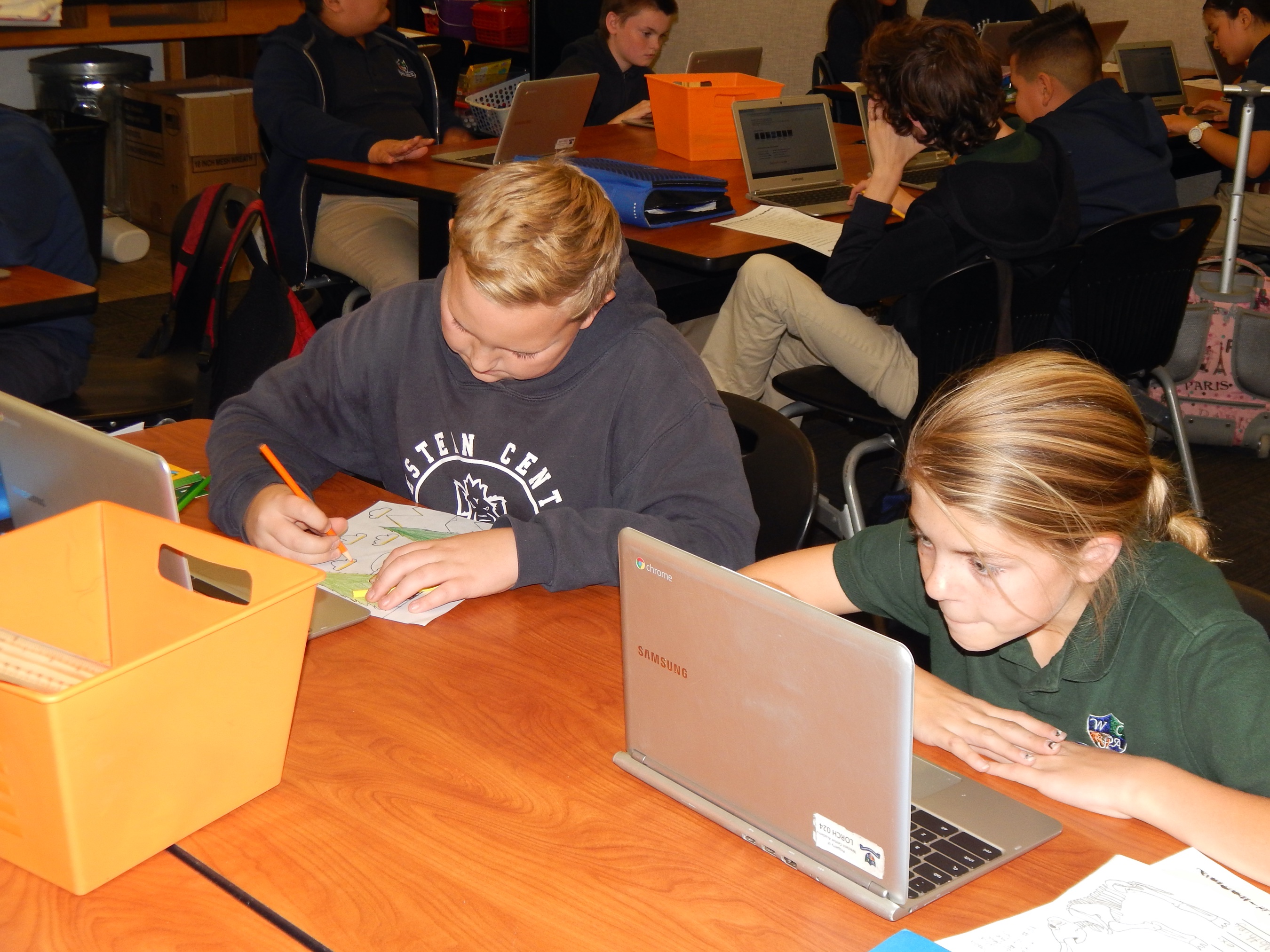
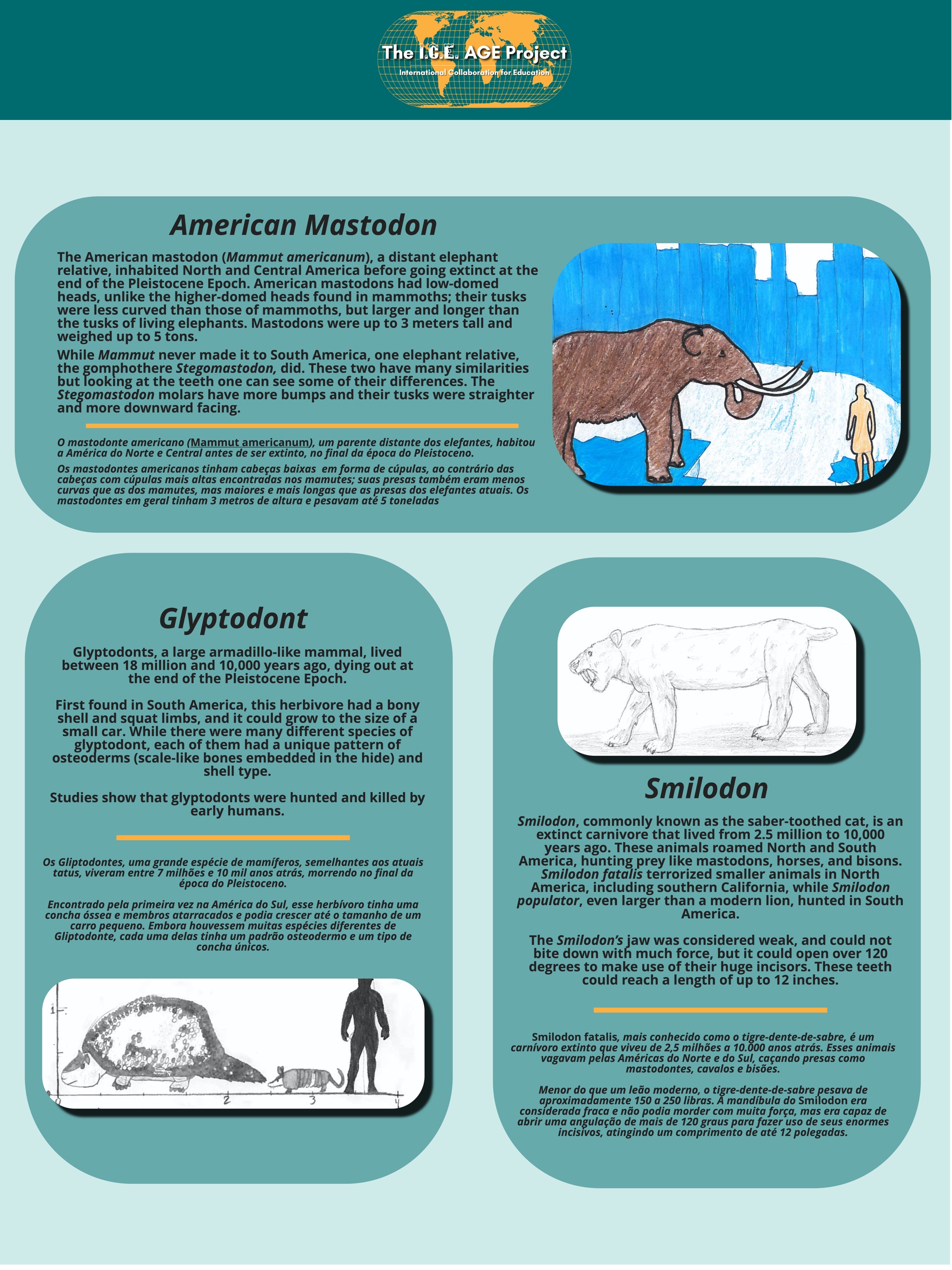
Collaborations 2 and 3
Collaboration 2 (another foreign I.C.E. Age version) paired Shirley, a seventh-grade teacher in California, and Diana in Brazil; collaboration 3 took place between a different seventh-grade class of Shirley’s and Rebecca’s third/fourth-grade combination class in Indiana. The only difference between the domestic and foreign collaborations was student domicile in or out of the United States. They used the same Webquest format and collaborated in the same manner, predominantly through Skype.
Evaluating Collaborations 2 and 3 Quantitatively
To determine the effect of domestic versus foreign collaboration on the American students’ global mindedness (including Cultural Pluralism, Responsibility, Efficacy, and Interconnectedness), the modified GMS was administered as both a pre- and posttest to the American students. Comparing the American students in the foreign versus domestic collaborations, we see (based on the lack of overlap in the critical ranges of the domestic and foreign groups’ means) that the foreign group’s adjusted posttest scores were significantly higher (p < .05) than the domestic group’s adjusted posttest scores for Cultural Pluralism, Responsibility, and Efficacy. However, there was no significant difference between the two groups regarding Interconnectedness, since the ranges of the two groups’ Interconnectedness means overlapped. Pretest scores were used as the covariable to adjust posttest scores during ANCOVA testing, which was used to compensate for not having a random assignment of students to treatment. Even the relatively short duration of the foreign collaboration seemed to have a salubrious effect on three dimensions of global mindedness (see Figure 5).
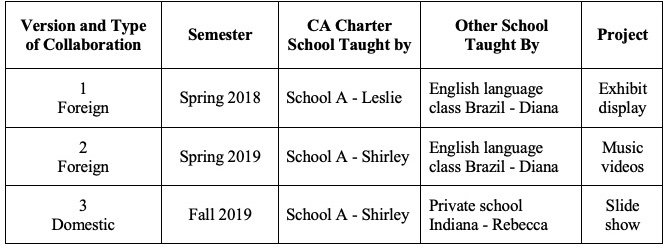
Themes Revealed
Observations of students during their collaborations and teacher and student interviews were analyzed for themes related to students’ global mindedness such as Cultural Pluralism. Transcribe (online software for transcription) was used to transcribe digital audio files of interviews into Word files. NVivo 12 for Mac was used for qualitative analysis of the interview transcripts and researcher’s journal of observations, helping the educator organize thoughts and make connections between observations and interview answers.
The analysis of interviews and observations about the various collaborations revealed four major motifs named by the researchers as global competencies, global mindedness, technology, and maturity. Only the first two are relevant to this discussion about global instruction carried out in cooperation between informal and formal education institutions.
Qualitative Analysis: Global Competencies
Global trends affect nearly every aspect of our lives from politics to the environment to technology, making global competency increasingly significant for today’s youth (OSCD 2020). Two of these capabilities, communicating ideas and recognizing perspectives, were among the dominant themes prevailing in the interviews and are also a part of World Savvy’s principles of global competencies through evidence-based practices (World Savvy, n.d.) (see Figure 6). The analysis yielded two global competency themes that we refer to as communication/collaboration and recognizing perspectives.
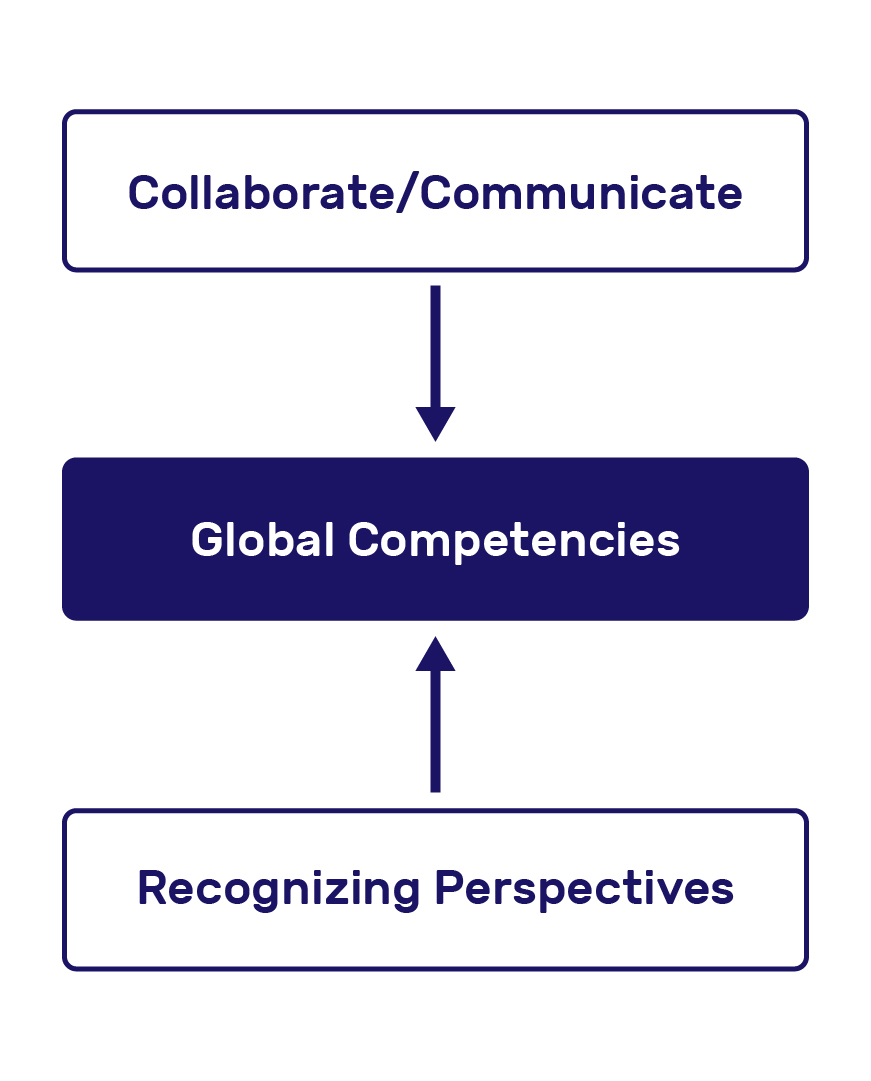
Theme 1: Communication/collaboration. An important aspect of communication is recognizing that when a person from a different country speaks English, it may be a second language. A student from California commented, “We had to like explain things like very clearly especially because like a lot of them English isn’t their first language, so we had to explain things like very thoroughly and clear. . . .” Another Californian student said, “Well, we had to um make sure that everyone was understanding what was happening and we were, we had to clarify to make sure that everyone was on the same page.”
Both students and teachers found value in the I.C.E. Age Project and the opportunities it presented to communicate and work with peers across the globe. As a third student said, “I think it would be good if other classes were able to collaborate with people from other countries and other states.”
Theme 2: Recognizing Perspectives. Students involved in the I.C.E. Age Project demonstrated the global competency skill of recognizing perspectives. A California middle schooler said,
[The foreign collaboration] allows people to look at other cultures, not in a lower way. Like how people usually look at cultures is like a low way, like you are better than them. Right? But now, people can see them as equals and have more respect for them.
The teachers also recognized the impact collaboration had on the students’ perspective. As the California teacher in collaborations 2 and 3 commented, “. . . I think it’s great because it gives them a perspective to be able to see the differences. But what I found with Brazil, what I loved most, is they were able to find their similarities.”
Qualitative Analysis: Global Mindedness
Four additional themes relative to global mindedness emerged during the qualitative analysis.
Theme 3: Cultural Pluralism. This means finding joy in learning about other people and cultures, appreciating the differences between cultures, and recognizing that they all bring value to one another. When talking about her attitude after the global collaboration project, a student from Shirley’s California class said, “I also find myself a little happier to find other students. I’m not sure why. It is just really cool and kind of joyous to do these kinds of things.”
Theme 4: Interconnectedness. This signifies having an appreciation for all people’s oneness and a realization that we interconnect in multiple ways. Shirley summarized her thoughts with, “… as a teacher looking at students, one of the funnest things for me is to see how incredibly similar that they all are . . . ’Cuz basically when it comes down to it, we’re all the same, we just live in a different place.” It was not just the teachers; students too noticed their sameness. When asked what changes she saw in her attitudes toward others throughout the global collaborative project, a student from Shirley’s class said, “it shows how different our knowledge is from each other, but it’s not that different actually.”
Theme 5: Responsibility. This implies the feeling of a connection with people in other parts of the world and a sense of moral obligation to help each other. A student from Indiana mentioned numerous times that she did not like group work until after working through this collaborative project. A California teacher, Leslie, commented that her students felt responsible for the project because they were (1) awed to be working with high school sophomores (2) excited to work with students from another country, and (3) intent on doing well since their work would be displayed in the museum.
Theme 6: Efficacy. This suggests taking part in national and international movements due to a feeling that each person is part of a significant change. While students made comments that reflect a sense of ability to change, none spoke of national or international movements specifically. A student commented on the current severity of climate change brought to mind by reading about the end of the Pleistocene warming. While addressing the problem, she did not mention any solutions.
The I.C.E. Age Project documentation, through both the qualitative and quantitative data, showed foreign collaborations led to gains in students’ level of global mindedness. Allowing students the freedom to shape the specific project they would like to do and providing access to peers from across the world kept the students engaged. All of the students interviewed had nothing but positive comments about the project. Outside of reference to technical and policy problems, the teachers’ comments were also entirely positive.
Challenges
A challenge arose at the beginning when working with a teacher in California. With collaboration 1, the teacher had some difficulty understanding the collaborative nature of the project. It was difficult to slow her class research down so it could be done with their international partners, in this case the students in Brazil. An open line of communication with the teachers was occasionally problematic as well. During one of the collaborations not described here, the project failed to reach completion because a teacher stopped responding to emails or text messages.
Some policy problems were encountered. A California school district blocked student access to Google outside of the school’s network. Thus, students could not share their research via Google Docs. A cumbersome process of students sending their documents to their teacher (Leslie), who would forward them to the Brazilian teacher-partner, was employed. Once finished, the Brazilian students would send their work to Leslie to disseminate to her California class. The district policy also meant students could not use Google Hangouts to communicate within their group. A whole-class Hangout or Skype session through the teacher’s account was necessary.
The collaborations faced technical difficulties; sometimes there was a weak signal quality during the Google Hangout meetings and a computer crashed another time, but none of the obstacles was insurmountable. All of these collaborations took place before the COVID-19 pandemic. It is possible that with the extensive use of videoconferencing in recent months, future collaborations will not encounter similar difficulties.
Practical Implications
Findings from this study have practical implications both within a classroom setting and for museums. Institutional participants were crucial for both sanctioning and supporting the collaborations. The facilitators, the second layer of the collaboration, also performed a critical role in preparing the students for the experience and knowing when to get involved. More significantly, they knew to simply let the students collaborate. Students, the actors in the classroom, responded well to the project’s informal nature. The student assessment was based on their research product, the nature of which the students determined at the outset of the collaboration (a diorama, exhibit, slideshow, or other means). If possible, within the school’s grading framework, such informal style projects may be worth exploring as the collaborative work actively engaged the students.
One of the most significant institutional changes observed through these collaborations was seen in the museum’s shift. WSC staff had never focused outside of the museum’s immediate service area. However, as a result of the I.C.E. Age Project, museum resources have been spent learning about and promoting fossils from Brazil, leading to an institutional change in mindset and promotion of its collections to a more global audience. Significantly, the I.C.E. Age Project also has helped put the museum’s collections into a more global context for WSC’s visitors. Museum educators are currently considering options to combine the I.C.E. Age Project with research exhibits, making global work more of its modus operandi.
Teachers who would like to engage their students in an I.C.E. Age Project should contact the lead author.
Brett Dooley (bdooley@westerncentermuseum.org) is an educator at Western Science Center in Hemet, California, and Walter Smith is a Professor of Curriculum and Instruction at Texas Tech University in Lubbock, Texas.
citation: Dooley, B., and W. Smith. 2021. Expanding Earth science learning through international collaboration. Connected Science Learning 3 (4). https://www.nsta.org/connected-science-learning/connected-science-learning-july-august-2021/expanding-earth-science
Earth & Space Science Research STEM Teaching Strategies Technology Middle School Informal Education


